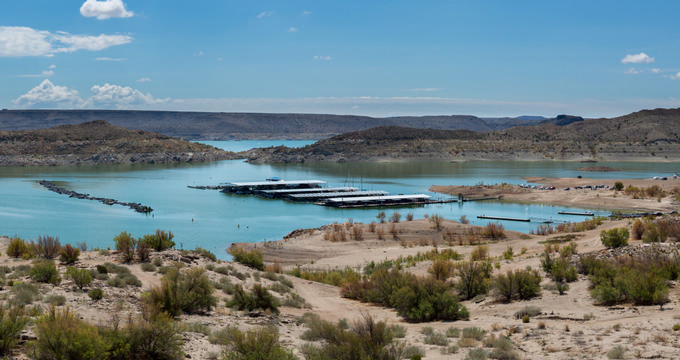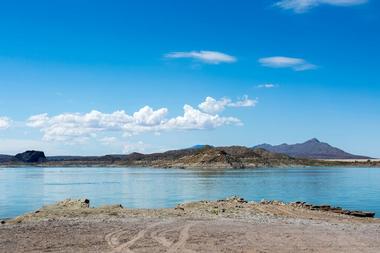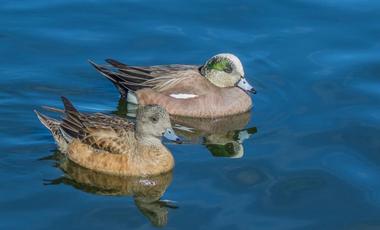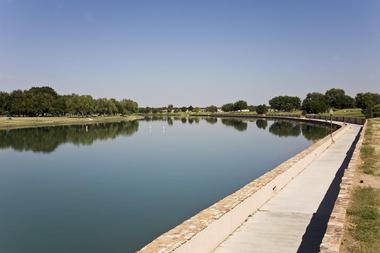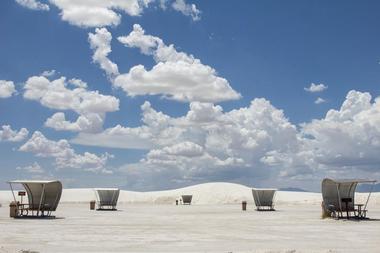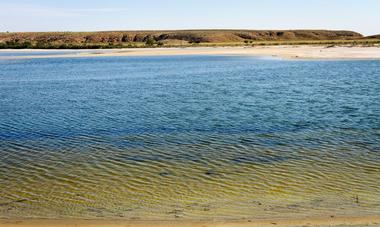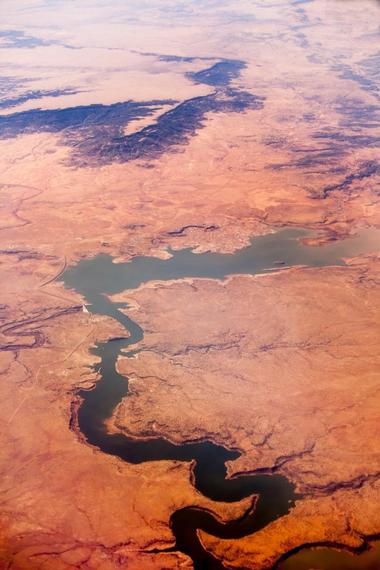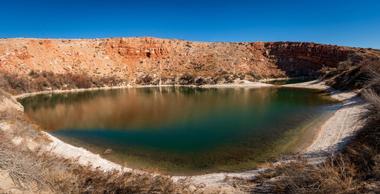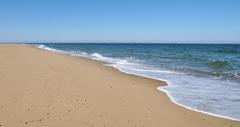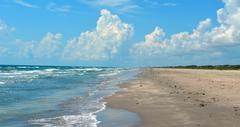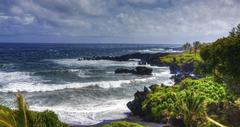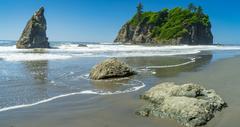When people think of New Mexico, they don't necessarily associate the state with beaches, but the Land of Enchantment is home to some lovely sandy strips and great water sources for sunbathing, swimming, water sports, and more. There aren't many beaches in New Mexico, but the old adage of 'quality over quantity' definitely applies to this state, with NM having a few beaches of truly exceptional quality. If you’re looking for a sandy spot to have some fun in this state, read through all the useful information in our New Mexico beach guide.
What are the 10 Best New Mexico Beaches?
The 10 Best New Mexico Beaches according to local experts are:
- Elephant Butte
- Tingley Beach
- Lake Carlsbad
- White Sands National Monument
- Lea Lake
- Navajo Lake State Park Beach
- Conchas Lake
- Bottomless Lakes State Park
- Park Lake
- More Info
More Ideas in NM: White Sands National Monument
Emerging from the heart of the Tularosa Basin in the northern Chihuahuan Desert in New Mexico, White Sands National Monument is one of the world's great natural wonders. The glistening white wave-like dunes of gypsum sand engulfs 275 square miles of desert, creating the world's largest gypsum dune field and breathtaking landscapes. The White Sands National Monument forms a large part of this unique dune field as a preservation area, which protects the unique flora and fauna that call the dunes home. The White Sands National Monument can be explored on a variety of walking trails which wind through the dramatic landscape of the dunes, including the Dune Life Nature Trail and the raised Interdune Boardwalk, both of which feature interpretive exhibits and information boards on the local wildlife. All trails begin at the White Sands Visitor Center, which has a variety of information about the White Sands National Monument and surrounding region.
The White Sands area was inhabited by the Mescalero Apache people who were already living in the field at the time when the dunes were discovered by U.S. Army officers in 1849. The area was first designated as a National Park in 1898 when a group of people proposed the region become a game hunting preserve, which did not come to fruition. After numerous proposals for the land, President Herbert Hoover created the White Sands National Monument in 1933, after which it was open to the public and still stands today.
The White Sands National Monument is located approximately 16 miles southwest of Alamogordo in the counties of Dona Ana and Otero and rests at an elevation of 4,235 feet within the mountain-ringed Tularosa Basin. The southern part of the basin is made up of 275 square miles of pristine white sand made up of gypsum crystals, making it the largest gypsum dune field of its kind in the world. Various forms of sand dunes are found in the White Sands region, ranging from transverse and barchan in the center of the area to parabolic dunes on the northern, southern, and northeastern borders. The Monument is surrounded by military installations, namely the Holloman Air Force Base and White Sands Missile Range and is sometimes closed to the public due to missile testing.
The White Sands National Monument is based next to the White Sands Missile Range in the heart of the Tularosa Basin in New Mexico and is open to the public at various times during the season. The Monument is sometimes closed for various periods of time due to missile tests on the White Sands Missile Range next door. Special permits for occasions such as weddings, commercial filming, and photography, and backcountry camping can be applied for. The White Sands National Monument has a ‘Leave No Trace’ ethic whereby the park aims to minimize human impacts on the environment.
The White Sands National Monument offers guided field trips for visitors of all ages with fact sheets for young learners and students. Field trips to the Monument can be enjoyed in a variety of ways – as self-guided trips, ranger-guided programs for youth and students, or ranger-guided curriculum-based programs for all ages. The Park also participates in a special Junior Ranger Program, which features a variety of age-group-specific activities.
White Sands Missile Range, New Mexico, Phone: 575-479-6124
You are reading "10 Best New Mexico Beaches " Back to Top
More Ideas in NM: Carlsbad Caverns
The Carlsbad Caverns National Park is located in the southeast corner of New Mexico in the Guadalupe Mountains. The desert landscape offers tabletop mesas, rocky canyons, and a network of over 100 underground caves beneath the Chihuahuan Desert. A visit to the park may begin at the Visitor’s Center with the 16-minute film, Hidden Worlds - Carlsbad Caverns National Park. The film uses high definition photography to showcase the natural wonders of the park including the caves, desert wildlife and flowering cacti.
The Natural Entrance Trail at the park guides guests along a stone walkway just over 1 mile into the Big Room chamber of the cavern, located over 750 feet below the surface. The Big Room is a 4,000-foot long natural chamber of limestone with a ceiling as high as 255 feet in some places. The chamber is the fifth largest in the United States, and the 28th largest known underground chamber in the world.
Guided tours take guests beyond the Big Room to several other named rooms among the underground network. Among these are King’s Palace, a highly decorated chamber which reaches depths of 830 feet below the surface. The 90-minute 1-mile tour requires a descent and a steep uphill exit. The Left Hand Tunnel tour is a moderately difficult lantern-guided tour. The 2-hour tour includes navigating steep, slippery slopes and is not recommended for those with difficulty seeing in low light. The 3-hour Lower Cave tour takes visitors down 60-feet of knotted ropes and wooden ladders into different chambers to view formations such as The Rookery, the Texas Toothpick and Colonel Boles Formation. The Slaughter Canyon Cave tour is a moderately difficult 6-hour adventure that takes guests to see one of the world’s tallest limestone columns, the 89-foot Monarch. Additional formations include the crystal-decorated Christmas Tree column, and the Chinese Wall. The cave is illuminated by flashlights and headlamps only, and all guests are required to bring three spare AA batteries for safety.
Above ground, several trails and backcountry treks allow guests to explore the Chihuahuan Desert, including the flowering cacti, agave and yuccas. The park is home to over 900 species and subspecies of vascular plants. Birding in the oasis area of Rattlesnake Springs is another popular activity. Over 350 species of birds can be found in the park, many in the isolated areas adjacent to the natural water source. The Rattlesnake Springs Historic District is a landscaped area surrounding the springs with a Pueblo Revival Style pump house built in 1933 and a Ranger’s Residence built in 1940.
History: The Park’s underground caverns were formed between 4 million and 6 million years ago when hydrogen sulfide escaping from fissures and faults in the limestone began mixing with the oxygen in rainwater to form sulfuric acid. The acid dissolved the limestone rock leaving behind clay, silt and gypsum deposits in the underground caves. Humans have been exploring the caves since pre-historic times, as evidenced by archeological finds in the area. Many of the cave’s ‘rooms’ were originally named by Jim White, who explored the park as a young boy in 1898 and later became a Park Ranger. Carlsbad Cave was designated as a National Monument in 1923, and was upgraded to National Park in 1930. Approximately two thirds of the park has been designated as a Wilderness Area, meaning no further changes will be made to the natural habitat. Both the Caverns and Rattlesnake Springs have been listed on the National Register of Historic Places. Over 380,000 guests visit the National Park each year.
Ongoing Programs and Education: The Bat Flight program takes place at Carlsbad Caverns from May through October each year. Visitors witness thousands of Mexican Free Tail Bats as they exit the caverns each evening at dusk in search of food. Bat Flight viewing takes place at the amphitheater outside the cave’s Natural Entrance. During the winter months, the bats migrate south to the Sierra Madre Oriental range in Mexico. Night Sky events are also popular as the park is located far from the city lights. Star Parties take place from May through the October immediately after the Bat Flight program. Guests may view the stars through the park’s high-powered telescopes. Rangers are on hand to answer questions, and educate visitors about the constellations, astronomy and local folklore. The ‘Give Me the Sun and the Moon’ program combines hiking with stargazing. On New Moon and Full Moon evenings, visitors hike with park rangers up to 1.5 miles through rugged desert terrain.
3225 National Parks Highway, Carlsbad, NM 88220, Phone: 575-785-2232
You are reading "10 Best New Mexico Beaches " Back to Top
More Ideas in NM: Taos Ski Valley
Located in Taos County, New Mexico, Taos Ski Valley is an alpine ski resort village town offering access to peak slope elevations of 12,481 feet, along with a resort village and suite accommodations. The present-day site of Taos Ski Valley was once home to the copper mining town of Twining, which was abandoned in the late 1800s. In 1955, the Taos Ski Valley resort was opened by Ernie and Rhonda Blake of Santa Fe, the managers of the Santa Fe Ski Basin.
History
At its opening, the resort featured access to a single ski slope, named Snakedance, and had little access to modern buildings and amenities until the mid-1960s, when the village area was incorporated. In 1956, a J-Bar ski lift was installed for the Snakedance slope, and the following year, a second chairlift was installed. Throughout the second half of the 20th century, the resort continued to add slopes and amenities, including a resort village and condominium accommodations. In 2013, the resort was purchased by American investor Louis Bacon, the founder and CEO of Moore Capital Management.
Permanent Attractions
Today, Taos Ski Valley is home to more than 55 independent businesses, including a variety of restaurants and overnight accommodations options. As the highest-elevated municipality in the United States, the 2.4-square-mile ski village sits at a maximum height of 12,581 feet, with average skiing elevations reaching 9,207 feet. Tourism comprises the majority of the village’s industry, with more than $12 million spent annually on skiing operations.
Five distinct skiing terrain parks are offered, including the Lower and Upper Front Side areas, the Bcak Side, the Highline Ridge, and the West Ridge. 110 skiing trails are featured, accommodating beginner, intermediate, and expert skill levels. Beginner and intermediate areas encompass roughly one-half of ski terrain and include Bambi Glade, Strawberry Hill, Whitefeather, Mucho Gusto, and Powderhorn. Higher-skill slopes are divided into advanced and expert categories and include Edelweiss, Inferno, Longhorn, Thunderbird, and three Kachina slopes, reaching a peak elevation of 12,481 feet. 15 chairlifts serve the slope areas, including the Kachina Lift, the highest triple chairlift in North America.
Located adjacent to Lift 1, The Blake is an 80-room alpine lodging house offering one- and two-bedroom, deluxe, and king suites. All guest rooms include amenities such as refrigerators, coffeemakers, and televisions serviced with DirecTV channels. Suites also include a gas fireplace and full kitchenette and laundry room area. Pet-friendly rooms are available upon request. The resort’s 192 at the Blake restaurant blends alpine and New Mexican architecture and decor styles, offering flatbreads, tapas, fine wine, and seasonal craft beer. A Spa and Wellness Center also offers massage, aromatherapy, and facial treatment services, and ski equipment and apparel can be purchased or rented at Taos Sports.
At the base of Lift 4 and Kachina Peak, the Bavarian Lodge and Restaurant offers four suites available for rental throughout the winter skiing and peak summertime seasons, including a three-bedroom suite for larger group accommodations. The resort’s restaurant offers a variety of authentic German dishes, including sauerbraten, wienerschnitzel, and käsespätzle, along with a large selection of imported German beers. American fare options such as sandwiches, salads, and burgers are also offered. Skiing packages through the resort offering complimentary lunch or dinner along with ski times are available for booking.
A variety of other dining options are offered throughout the resort area, including Rhoda’s Restaurant, which serves authentic New Mexican cuisine made from fresh, locally-sourced ingredients. At the base of Lift 6, the Whistlestop Cafe offers custom-made flatbreads and soups served in bread bowls, while the Phoenix Grill, located at the bottom of Lift 4, serves pulled pork dishes and craft beers. Grab-and-go options are offered at the Tenderfoot Katie’s Food Court, and after-ski cocktails are served at the Martini Tree Bar.
Ongoing Programs and Events
A number of annual skiing competitions are hosted at Taos Ski Valley throughout the year, including the Junior Taos Freeride Nationals, held the second week in February. Also in February, the Rio Hondo Rando Raid event is host to the US Ski Mountaineering Nationals Sprint and Team Races. Public special events throughout the skiing season include a Femme de Freeride women’s skiing festival, a Brewmaster’s Festival, and New Year’s Eve festivities featuring midnight skiing, a torchlight parade, and fireworks. A variety of arts and culture events are also hosted throughout the year in the village of Taos, including the Frank Morgan Jazz Festival, film and lecture series hosted by the Taos Center for the Arts, and First Friday gallery crawl events in the village’s arts district.
116 Sutton Place, Taos Ski Valley, NM 87525, Phone: 800-776-1111


